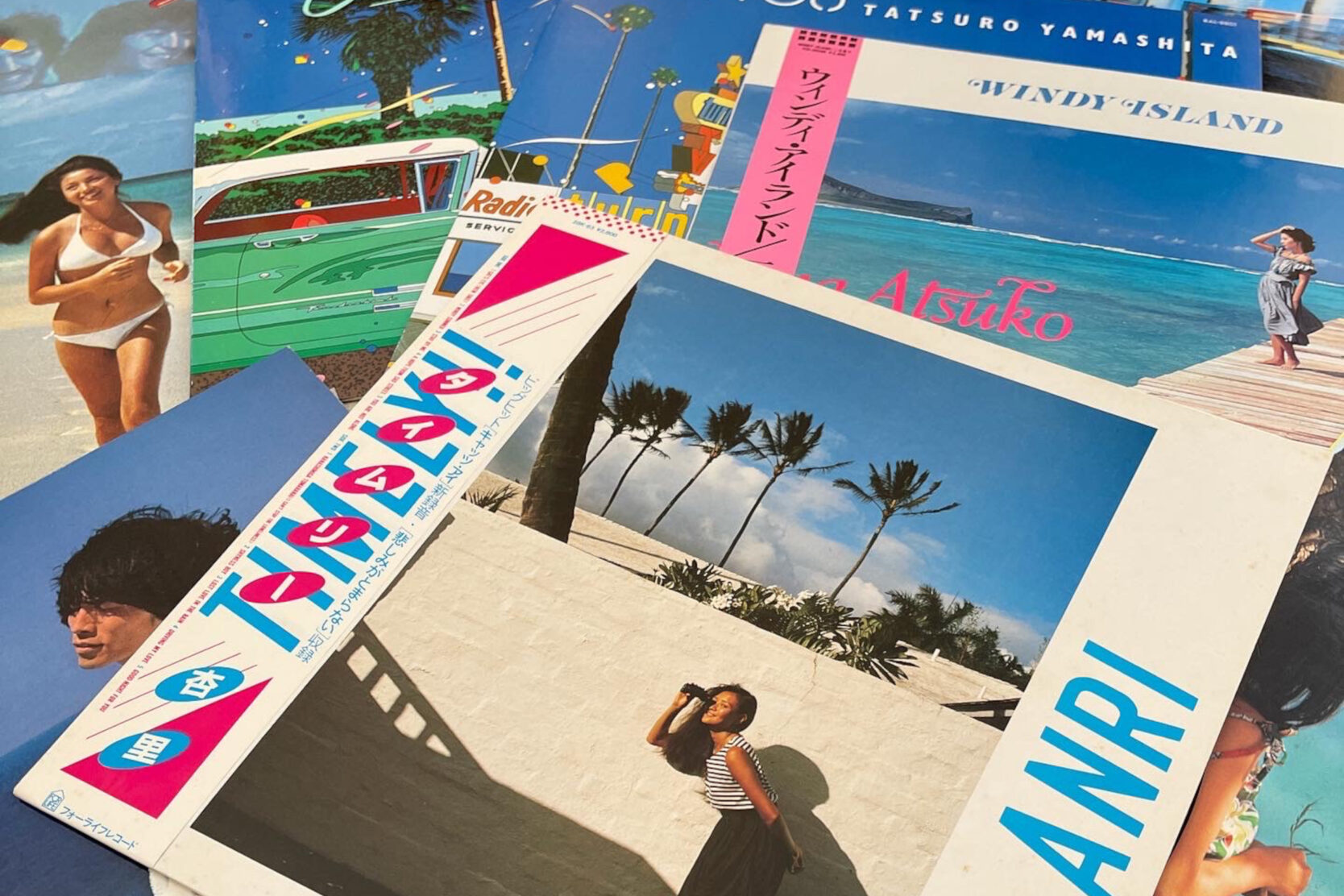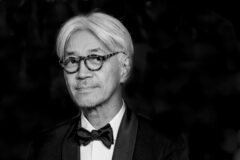Coachella is a great time to be left alone in L.A. While the festival in the desert rages, the crowd recedes from the city of Los Angeles, revealing tide pools of culture of a different kind. It’s a low tide that shines a light on scenes both newly emerging and old but resilient who come out to play. The noise of culture’s competition for our ears and eyes dials down, and you can, for a moment, listen to yourself think.
This was the quiet in which I heard City Pop for the first time.
When the elevator doors opened to the rooftop of the Ace Hotel, they opened to a milder crowd of Nochella mainstays. It’s a multigenerational scene adorned in fashionable multicultural dress. Most are dancing with a cocktail in one hand and a stack of records in the other, each bound by a paper belt about three inches wide. That paper strip is called an OBI, and they are a signature of Japanese imported vinyl. It’s the OBI that makes them a collector’s item.
Through weekend one and two of our emptied city, I found myself drawn to different locations for the same party in the not-Coachella scene. These pop-up parties are animated by an urgency to move between the bar, the dance floor, and the crates of vinyl at its perimeter to dig for hidden gems. It’s a hunter-gatherer instinct propelled by the want for something aged. It’s the search for “then” over “now,” with dopamine hits of discovering authenticity captured in wax, free from the algorithmic influences of today where the content hunts for you.
I’ve long been a subscriber to that culture of building my collection of classic rock, jazz, and soul. Album-Oriented Rock. To be honest, I’d gotten a bit bored with it, having gluttonously consumed my way through decades of Americana, until I was pulled back in by the discovery of another nation’s nostalgia. City Pop hit like a new sound for me, but it comes from an older Japan. Stepping into these parties with the City Pop name loudly brandished on signs and featured as the name of specialty cocktails and having its own designated crates, I could see I was not the only moth drawn to this flame. If anything, I was late.

Narrowly defined, City Pop is Japanese pop music from the 1970s and ‘80s. Its sound is so irrepressibly saccharine and so devotionally produced to perfection, it stands today as the optimistic soundtrack to an economic boom, for American listeners like me, a distant time in a distant land. City Pop, if nothing else, has the charm of being far away from here and now. That charm is what makes it so addictive.
Algorithmic-assisted playlisting and the deep digital catalogs they pull from have collapsed modern listening into a cultural singularity. The multi-hyphenate of decade and nation are together one genre that even new artists will channel in unabashed neo-retro, referential form. 1970s Nigerian disco. 1960s Brazilian psychedelic rock. 1980s South African boogie. 1990s Mexican ambient sounds. They all have their playlists. They all have their crates. They all have their Silk Sonics. Upstart labels like Light In The Attic and Soundway Records have stepped in as a new curating force to sprinkle into the growing vinyl record market new editions of remastered compilations. It’s the sonic equivalent of trendcore.
Yet among all of these nation-decade genres, this Japanese Pop from the ‘80s stands tall with its own precise and distinctive name of City Pop seemingly designed to welcome new listeners in. It’s a paragon experience of asynchronous culture in which anyone, anywhere can onboard to their discovery of a fandom anytime. Async culture stands in contrast to algorithmic culture. It’s about you finding it, rather than it finding you.
It’s an IRL extension of an online fandom lurking underneath what’s trending now, gathering in forums like Reddit, Discord, and Instagram to co-create onboarding materials for a new canon of essential City Pop artists and albums.
It’s equal parts detective work and redefinition of another culture according to the modern Internet’s gaze. Whoever you are, you’re not from then and you’re not from there. City Pop is a closed system. It’s over and done. That’s what makes the novelty of discovering it huge.

The rise of City Pop has been well documented by SPIN since 2018, as well as by Pitchfork and VICE when vaporwave and future funk DJs began sampling its classic tracks. Its popularity continues to be propelled not only by disc jockeys and disc collectors, but by viral TikToks, Instagram Reels, and the routine recurrence of old City Pop bangers like “Plastic Love” by Mariya Takeuchi on the front page of Reddit.
These digital trails are encouraging Japanese record labels to amplify the growing hype even further, by removing region locks on streaming rights for some of the most sought-after City Pop artists and to update track meta-data to be search-friendly for English-speaking listeners. The result is a flywheel of a re-emerging lost culture that has grown enough to catch the attention of Japan’s Ministry of Cultural Affairs.
In 2022, the Weeknd, who regularly jockeys for position as the most listened-to artist in the world, released a single called “Out Of Time.” It was a full-track sample of 1983 City Pop classic “Midnight Pretenders” by Tomoko Aran. It came a year after rising artist Jenevieve’s single “Baby Powder” sampled note-for-note City Pop artist Anri’s 1982 song “Last Summer Whisper.”
The sounds of City Pop itself and the J-Pop stars it created were born from a soup of Western soft power influences; American jazz, banned during 1930s/’40s wartime Japan; and the rock and soul and funk that later evolved from it. City Pop itself gladly sampled American pop like Hall & Oates well through the ‘80s. That makes these contemporary American hits that in turn sample Asian sounds oddly shaped gems to behold. They are deeply layered glass onions of cross-cultural gaze. You can see in them the dialogue of cultural exchange, and held up to your ear, you can hear in it an observable fact: Culture is power. Why else would it keep being taken, traded, and torpedoed back and forth across the decades and seas?
Asian artists were a notable feature at Coachella in 2023. South Korea’s Blackpink headlined and were accompanied on the line up by DPR LIVE and DPR IAN also from South Korea, along with Sunset Rollercoaster from Taiwan, Jackson Wang from Hong Kong, and others with blended American and Asian roots. Yet in spite of Tokyo-based graphic designer Verdy being tapped as artist-in-residence, J-Pop was absent.
Blackpink headlining Coachella in 2023 raised the watermark of K-Pop’s influence on Western culture. It didn’t just happen for no reason. The sensations from the east, BTS and Blackpink the latest among them, have more than asserted their place in the ongoing global tug-for-attention measured in hashtags on social feeds and magazine ink. Where attention goes, money flows; and wherever money flows, there’s always a deeper story underneath.

K-Pop’s mainstage takeover represents a key win in the government-funded soft power strategy known as the Korean Wave. Soft power is defined as the use of positive attraction and persuasion to achieve foreign policy objectives. For South Korea, this has meant strategically deploying cultural assets in film, comics, games, consumer products, and, most effectively of all, pop stars.
BTS alone commands an estimated $5 billion for the Korean economy, half a percentage point of South Korea’s gross domestic product. Their fandom is a key asset, operating like a self-ascribed militant force calling themselves the “BTS Army” and routinely launching hostile takeovers of social media hashtags to dominate online conversations across the world. In the wake of the trends they and others like Blackpink make is a powerful current that drives Korean products, tourism, and immigration as a force to influence trade partnerships and global policies.
The Korean Wave is, by design, winning over hearts, minds, and wallets. Soft does not mean subtle.
South Korean media covers the Korean Wave like any nation covers their government’s foreign policy strategy. In January of 2023, The Korean Herald shared headlines from the New Year’s summit as the Ministry of Culture, Sports and Tourism pledged a goal to achieve $22 billion in content exports by 2027, an ambitious march up from the $12.4 billion in 2021. Korean President Yoon Suk Yeol offered his support of the strategy, stating, ”This is something that has an intuitive impact on all other industries, including infrastructure and arms, by improving the Republic of Korea’s image. So it’s important to not only export K-content, but from now on, I expect the content industry to become the most significant area in fortifying our capabilities and increasing our export power.”
The “Korean Wave” strategy stands tall today, but it doesn’t stand alone. It began in 1997 after an Asian financial crisis prompted South Korea’s military to soften their grip on media censorship in search of a new economic strategy to stimulate growth.
They had a blueprint to work off of: Cool Japan, an older soft power strategy, launched in 1980 by the Japanese government as a propellant to a bull-run of economic boom that extended their influence across the globe through food, art, music, and consumer products.

Just as American teenagers back then tuned out the sounds of the world with their Sony Walkmans, teenagers today do the same as they scroll through their Samsung phones. Neither might care to think that the music they like and the devices they play it on are but pieces on the gameboard of a government-backed strategy planned by nations oceans away. Neither would I like to think that my newfound obsession with City Pop is fueled by anything but my own genuine knack for discovery.
For South Korea and Japan, the interplay between the Korean Wave and Cool Japan soft power strategies are central to diplomatic relations. These strategies matter. They are essential to deepening each other’s cultural integration among the populace. High favorability between South Korean and Japanese people helps to fortify a marriage of imports and exports that fuels joint economic growth and is a hard-won friendship working to overcome a deep and troubled rivalry.
So when Japanese media vocally criticizes the government’s management of the Cool Japan strategy as being outmaneuvered by the Korean Wave, it carries a heavy context. It’s a Cool War being fought on multiple fronts: music, food, tourism, art, comics, film, even spirituality.
In the arms race of global pop, one wonders how today’s game board would be set if Michael Jackson’s 1983 cover of iconic City Pop band Yellow Magic Orchestra had made it onto Thriller instead of being dropped at the last minute due to a disagreement of terms.
Still, slowly, quietly, and certainly, City Pop rises. It stands as an emerging oddity among the Cool Japan critique. Is City Pop old or is it new? With 40 years behind the launch of Cool Japan, it has started to foster its own form of pop culture tradition. While K-Pop is the sensation for global audiences now, J-Pop was something of a self-contained sensation when these soft power strategies first began. As far out ahead as Korea may seem today, perhaps Japan has a force to leverage that Korea is ill-equipped to beat: nostalgia.
What’s new is cheap. What’s old is priceless.
All culture from this decade and beyond will be made with, in response to, or in defiance of A.I. Whatever form the next soft power game will take, it is those nations with the deepest crates of verifiable authenticity in their cultural collection that have the most valuable assets to trade.
Fandom becomes meaningless when it’s fake.





